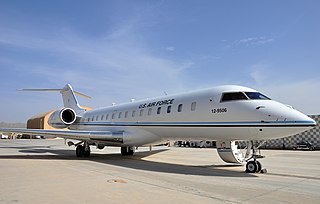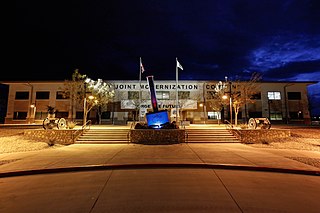
The Defense Information Systems Agency (DISA), known as the Defense Communications Agency (DCA) until 1991, is a United States Department of Defense (DoD) combat support agency composed of military, federal civilians, and contractors. DISA provides information technology (IT) and communications support to the President, Vice President, Secretary of Defense, the military services, the combatant commands, and any individual or system contributing to the defense of the United States.

ISTAR stands for intelligence, surveillance, target acquisition, and reconnaissance. In its macroscopic sense, ISTAR is a practice that links several battlefield functions together to assist a combat force in employing its sensors and managing the information they gather.

In current military use, combined operations are operations conducted by forces of two or more allied nations acting together for the accomplishment of a common strategy, a strategic and operational and sometimes tactical cooperation. Interaction between units and formations of the land, naval and air forces, or the cooperation between military and civilian authorities in peacekeeping or disaster relief operations is known as joint operations or interoperability capability.

The Electronic Systems Center was a product center of Air Force Materiel Command (AFMC) headquartered at Hanscom Air Force Base, Massachusetts. Its mission was to develop and acquire command and control, communications, computer, and intelligence systems. ESC consisted of professional teams specializing in engineering, computer science, and business management. The teams supervised the design, development, testing, production, and deployment of command and control systems. Two of ESC's most well-known developments were the Boeing E-3 Sentry Airborne Warning and Control System (AWACS), developed in the 1970s, and the Joint Surveillance Target Attack Radar System, developed in the 1980s.

The United States Joint Forces Command (USJFCOM) was a Unified Combatant Command of the United States Department of Defense. USJFCOM was a functional command that provided specific services to the military. The last commander was Army Gen. Ray Odierno and the Command Senior Enlisted was Marine Sergeant Major Bryan B. Battaglia. As directed by the President to identify opportunities to cut costs and rebalance priorities, Defense Secretary Robert Gates recommended that USJFCOM be disestablished and its essential functions reassigned to other unified combatant commands. Formal disestablishment occurred on 4 August 2011.

The Air Force Intelligence, Surveillance and Reconnaissance Agency was until 29 September 2014 a field operating agency of the United States Air Force headquartered at Lackland Air Force Base, Texas. On that date it was redesignated Twenty-Fifth Air Force and aligned as a numbered air force (NAF) of the Air Combat Command.

Command and control is a "set of organizational and technical attributes and processes ... [that] employs human, physical, and information resources to solve problems and accomplish missions" to achieve the goals of an organization or enterprise, according to a 2015 definition by military scientists Marius Vassiliou, David S. Alberts, and Jonathan R. Agre. The term often refers to a military system.

The Battlefield Airborne Communications Node (BACN) is a United States Air Force (USAF) airborne communications relay and gateway system carried by the unmanned EQ-4B and the manned Bombardier E-11A aircraft. BACN enables real-time information flow across the battlespace between similar and dissimilar tactical data link and voice systems through relay, bridging, and data translation in line-of-sight and beyond-line-of-sight situations. Its ability to translate between dissimilar communications systems allows them to interoperate without modification.
Marine Corps Operational Test and Evaluation Activity (MCOTEA) is the independent Operational Test and Evaluation (OT&E) authority for the U.S. Marine Corps. MCOTEA plans, executes, and evaluates testing of material solutions against warfighter capabilities, under prescribed realistic conditions and doctrine, to determine Operational Effectiveness, Operational Suitability, and Operational Survivability (OE/OS/OSur) of all new equipment for the Corps in support of its acquisition process. MCOTEA is based at Marine Corps Base Quantico. Unlike most Marine Corps organizations, MCOTEA has a Director instead of a Commander.

The 363rd Intelligence, Surveillance and Reconnaissance Wing is a United States Air Force unit. The group is assigned to the United States Air Force Sixteenth Air Force, stationed at Joint Base Langley-Eustis, Virginia.

Marine expeditionary unit (special operations capable) (MEU(SOC)) is a program created by the United States Marine Corps (USMC) and the United States Navy (USN) in 1985 for Marine expeditionary units (MEU). The program enhances MEUs providing them with additional training and equipment to become certified as special operations capable with a Maritime Special Purpose Force (MSPF). The designation special operations capable is unique to the Marine Corps and means in relation to special operations. The role of a MEU(SOC) however is not equivalent to the special operations role of special operations forces. Although considered special operations capable a MEU(SOC) does not form part of the United States Special Operations Command (USSOCOM) established in 1987 or the United States Marine Forces Special Operations Command (MARSOC) later established in 2006.

The Air Force Command and Control Integration Center was an Air Combat Command field operating agency responsible for innovating, designing, developing, integrating, and sustaining command and control capabilities. It was a tenant unit at Langley Air Force Base, with several outlying support locations.

The Marine Personnel Carrier (MPC) is a wheeled armored personnel carrier under development for acquisition by the United States Marine Corps. The program was canceled in 2013 but resurrected in 2014 as part of phase one of the Amphibious Combat Vehicle.
The Five Eyes Air Force Interoperability Council(AFIC) is a formal military organisation, consisting of the "Five Eyes" countries, Australia, Canada, New Zealand, the United Kingdom and United States. The organisation is responsible for enhancing Air Force interoperability amongst member nations' Air Forces. The use of the term "Five Eyes" stems from the informal name for the intelligence sharing network consisting of Australia, Canada, New Zealand, United Kingdom and United States.

The U.S. Army Joint Modernization Command, or JMC, based in Fort Bliss, Texas, gains insights from "Fight Tonight" units about future ways of fighting, future technology, and force structure during realistic live, constructive, and/or simulated training exercises. Joint Modernization Command is subordinate to the Army Futures & Concepts Center in Joint Base Langley-Eustis, Virginia; both report to the U.S. Army's newest Four-Star Command, the Army Futures Command (AFC) based in Austin, Texas.
A battle lab or battle laboratory is an organization dedicated to studying changes in the military.

The Combined Joint Expeditionary Force (CJEF) is a UK–French military force. It draws upon both the British Armed Forces and the French Armed Forces to field a deployable force with land, air and maritime components together with command and control and supporting logistics.

Twenty-Fifth Air Force, also known as Air Force Intelligence, was a numbered air force (NAF) within the United States Air Force (USAF), and served as the Air Force's premier military intelligence organization. 25 AF was established on 29 September 2014 by redesignating the Air Force Intelligence, Surveillance and Reconnaissance Agency under Headquarters, United States Air Force, to a numbered air force aligned under Air Combat Command. The USAF also realigned the 9th Reconnaissance Wing and the 55th Wing under the new NAF. It was headquartered at Lackland Air Force Base, Texas.

The Joint Deployable Analysis Team (JDAT) is part of the J6 Directorate of the Joint Chiefs of Staff.
The transformation of the United States Army is part of a strategy using Multi-Domain Operations (MDO). In 2019, the planning was for Large Scale ground Combat Operations at echelons above the brigade combat team. Multi-Domain Task Forces operate in a combatant commander's theater.















